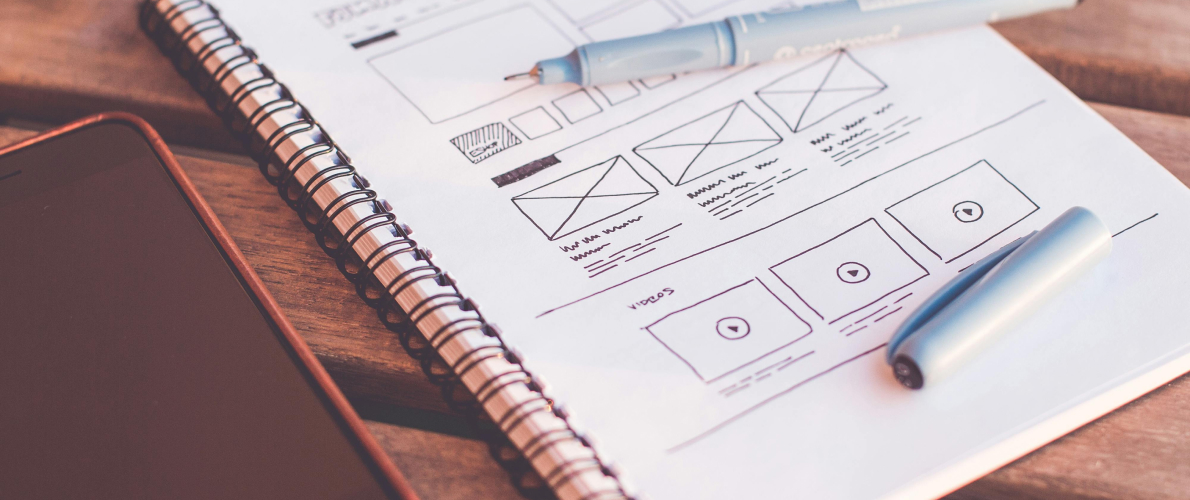If you try to take a look around you, you will notice everything in this world is designed. From the way you communicate, the way you eat and the way you work. You can say that design is everywhere. The user experience design can be found in ancient history. The architecture, the food, clothing styles. Although these things changed with time, keeping in mind our needs and necessities. But the few qualities like durability, usefulness and aesthetics are still being maintained in the designs that we see today.
Before the 70’s UX design was known as HCI (Human Computer Interaction) which was with long lines of codes. Only after that when personal computers were invented by Xerox PARC where they used icons and other graphic elements in these computers the term changed to GUI (Graphical User Interface)
In the 80s and 90’s when people started using personal computers, they tried to find out how users should interact with computers. And how can we make this interaction more intuitive as we interact with humans? People associated with HCI (Human Computer Interaction) were the people who were cognitive psychologists or computer scientists. As this field started to grow, they noticed that this needed the involvement of other fields as well like motion graphics and storytelling.
“UX design” is a term coined by Don Norman
“No product is an island. A product is more than the product. It is a cohesive, integrated set of experiences. Think through all of the stages of a product or service from initial intentions through final reflections, from the first usage to help, service, and maintenance. Make them all work together seamlessly.”
– Don Norman
User Experience Design is a person’s perception and responses that results from anticipated use of products, services or systems.
A UX Design should be able to answer 5 simple questions…
What, Where, When, Why and Who would use the product service or system.
UX Designer’s job is to combine user needs and business needs. The design should value the user’s life and the product should be profitable to the business. If the user is not satisfied with the product’s design, he/she goes to your competitor.
UX Design is a multidisciplinary field which often includes Visual Design, Interaction Design and Psychology and it’s not a linear process.
The UX Design Process:
1. Research
- Set up KPIs & Business outcomes
- Desk Research - Data Analysis (Quantitative / Qualitative)
- Customer Interviews
- Competitor Analysis
- Customer Journey
2. Planning
- Create user stories
- High Level user flow
- Sitemap
3. Conceptualize
- Preliminary Sketeches
- Wireframes
- Information Architecture
- Prototyping
4. Design
- Hi-Fidelity Design
- Responsive Design
- Clickable Prototype
- Design Documentation
5. Analyze
- Assessing the outcome
- A/B Testing
- User Testing
UX is all about the user
UX designers focus on creating a user-centered design so that the user experience is meaningful to them. The UX design process includes the user journey, usability testing, design decisions, visual design, and even elements of psychology.
They define the overall feel of the application. Creates wireframes and prototypes which helps base the product’s user flow and ensure that the user flow is realized properly is consistent.
A UX designer’s goal for a user is to have a positive interaction with a product or service. Whether the interaction solves a problem, provides entertainment, the experience should leave the user feeling fulfilled.
What tools does a UX designer use?
UX designers employ a range of tools at each stage of the design process for research, wireframing and prototyping, collaboration with teams, and testing designs. Below is a list of commonly used tools categorized:
1. Research and User Testing
- Google Forms, Typeform, Qualtrics
- Google Analytics, Hotjar, Mixpanel
- UsabilityHub, Lookback, Maze
- Optimal Workshop (for tree testing, card sorting)
- Dovetail (research repository)
- Miro, Mural (collaborative affinity mapping)
2. Wireframing and Prototyping
- Figma, Adobe XD, Sketch
- Axure RP, Marvel, Framer
- Zeplin, Avocode
3. Visual Design
- Adobe Photoshop, Adobe Illustrator
- Figma
- Canva (for quick assets or presentations)
4. Collaboration and Documentation
- Slack, Microsoft Teams
- Notion, Confluence
- Google Workspace (Docs, Sheets)
5. Accessibility
- Stark (for accessibility testing)
- WAVE, Axe (web accessibility evaluation tools)
6. Development Handoff
- Zeplin, Figma Inspect, Adobe XD Share
7. Productivity
- Trello, Jira, Asana
- MindMeister, Miro
Key Skillsets for a UX Designer
A UX designer has a diverse set of skillset, encompassing technical, creative, analytical, and interpersonal abilities. Here’s an overview of key skills every UX designer should have:
1. User Research and Analysis
Understanding users is the foundation of great design. Conducting user interviews, surveys, usability tests, and other research methods helps uncover user needs, behaviors, and pain points. Being able to analyze data—both qualitative and quantitative—is essential for making informed decisions. Creating personas and mapping out user journeys are critical for empathizing with users and aligning the team on goals. Competitive analysis is also a valuable tool to stay ahead and learn from industry trends.
2. Wireframing and Prototyping
Sketching out ideas and turning them into wireframes is where the creative problem-solving begins. Wireframes provide a blueprint of the layout and user flow. Prototyping brings designs to life by making them interactive, enabling quick feedback and iterations. A solid grasp of information architecture ensures users can navigate content logically and efficiently.
3. Visual Design
Strong visual design skills help create interfaces that are not just functional but also aesthetically pleasing. Knowing how to use color, typography, spacing, and other design principles effectively is crucial. Developing or working within a design system ensures consistency across products. Aligning visuals with branding adds value and reinforces the product’s identity.
4. Interaction Design
Good interaction design makes products feel intuitive and engaging. This includes designing microinteractions that guide users, as well as crafting animations and transitions to add polish. A deep understanding of usability principles ensures the experience feels seamless and natural.
5. Collaboration and Communication
UX design is a team effort. Collaborating with developers, product managers, and other stakeholders is an everyday task. Communicating ideas clearly—whether it’s through presentations, documentation, or informal discussions—keeps everyone aligned. Being open to feedback and knowing how to incorporate it into designs is key to delivering the best results.
6. Technical Skills
Being proficient with industry-standard design tools like Figma, Adobe XD, or Sketch is non-negotiable. A basic understanding of front-end technologies like HTML and CSS helps bridge the gap between design and development. Familiarity with analytics tools like Google Analytics or Hotjar is also helpful for validating design decisions.
7. Problem-Solving and Critical Thinking
Design is about solving problems. Identifying the root cause of an issue and addressing it through thoughtful design solutions is a core skill. Empathy for the user drives this process, ensuring the solution is meaningful. Iteration is part of the journey—testing, refining, and improving until the design truly works.
8. Accessibility and Inclusivity
Designing for everyone is a responsibility. Understanding accessibility standards like WCAG ensures products are usable by people with disabilities. Inclusive design considers diverse user groups and creates experiences that are equitable and fair.
9. Business Acumen
UX design doesn’t exist in isolation—it needs to align with business goals. Understanding how designs impact KPIs and balancing user needs with business constraints is vital. Managing stakeholder expectations while advocating for the user requires both diplomacy and strategic thinking.
10. Soft Skills
Empathy and curiosity are at the heart of UX design. Staying curious about user behavior and having the adaptability to navigate changing requirements are essential traits. Time management skills help juggle deadlines without compromising quality. At the end of the day, being a great UX designer means being approachable, thoughtful, and passionate about creating meaningful experiences.
How to become a UX Designer?
Becoming a UX designer isn’t a linear path—it’s a journey that blends creativity, empathy, and problem-solving. If you’re starting out, here’s a roadmap to help you build your career in UX design:
1. Understand What UX Design Is
Start by understanding what UX design entails. It’s about improving the overall experience users have when interacting with a product, whether it’s a website, app, or physical device. Learn the core principles: usability, user research, interaction design, accessibility, and information architecture.
2. Learn the Fundamentals
Familiarize yourself with the basics of design and human psychology. Dive into topics like:
- Design principles (contrast, alignment, spacing, and hierarchy).
- Cognitive biases and how they influence user behaviour.
- Usability heuristics (e.g., Jakob Nielsen’s principles).
3. Develop Key Skills
Focus on essential UX skills like:
- User Research: How to conduct interviews, surveys, and usability tests.
- Wireframing & Prototyping: Use tools like Figma, Adobe XD, or Sketch to bring ideas to life.
- Visual Design: Learn about color theory, typography, and creating cohesive UI designs.
- Accessibility: Understand how to make designs inclusive for all users.
4. Explore Design Tools
Start using industry-standard tools. These include:
- Figma or Adobe XD for design and prototyping.
- Miro or Mural for brainstorming and collaboration.
- Zeplin or similar tools for developer handoffs.
5. Build a Portfolio
A strong portfolio is your ticket into UX design. Work on personal projects, volunteer for non-profits, or redesign existing products to showcase your skills. Focus on presenting:
- The problem you solved.
- Your research process.
- How you arrived at the final solution.
- Key takeaways or lessons learned.
6. Learn From Others
Immerse yourself in the design community. Follow blogs, watch tutorials, and connect with UX designers on platforms like LinkedIn or Twitter. Attend webinars, workshops, and design meetups to stay inspired and up-to-date on trends.
7. Gain Practical Experience
Internships or entry-level roles are a great way to start. Even freelance work or collaborating with startups can help you understand how UX works in real-world scenarios. Focus on applying what you’ve learned and adapting to team environments.
8. Study Case Studies
Analyze UX case studies to see how others approach design problems. Platforms like Medium, UX Collective, or Behance often feature detailed breakdowns of design processes. They’re excellent for learning and inspiration.
9. Focus on Soft Skills
Being a UX designer isn’t just about technical skills. Work on:
- Empathy: Always prioritize understanding user needs.
- Communication: Be clear when presenting ideas and accepting feedback.
- Collaboration: Design is rarely a solo effort.
10. Stay Curious and Keep Iterating
UX design is a constantly evolving field. Stay curious, keep learning, and don’t be afraid to iterate on your skills and designs. The more you experiment and refine, the better you’ll get.
Final Thoughts
The world of UX design goes far beyond a beautiful product; it is creating intuitive, accessible, and enjoyable experiences for its users. It combines creativity, psychology, and problem-solving to address real-world problems, whether the need is to simplify a checkout process or push accessibility forward by designing delightful interactions. As technology evolves, the importance of UX in making meaningful and impactful products is also increasing. Ultimately, it’s about people understanding them and how they feel empowered and satisfied when using a product.




Seems interesting
You could definitely see your enthusiasm in the work you write. The arena hopes for more passionate writers like you who aren’t afraid to say how they believe. All the time follow your heart. “The most profound joy has more of gravity than of gaiety in it.” by Michel de Montaigne.
I have been exploring for a little for any high quality articles or blog posts on this sort of house . Exploring in Yahoo I ultimately stumbled upon this site. Reading this info So i¦m glad to exhibit that I have a very excellent uncanny feeling I found out just what I needed. I most for sure will make certain to don¦t fail to remember this site and give it a look on a continuing basis.